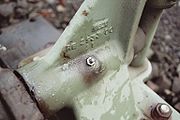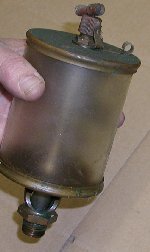
Grease fitting
Encyclopedia

Lubricant
A lubricant is a substance introduced to reduce friction between moving surfaces. It may also have the function of transporting foreign particles and of distributing heat...
s, usually lubricating grease
Grease (lubricant)
The term grease is used to describe semisolid lubricants. Although the word grease is also used to describe rendered fat of animals, in the context of lubrication, grease typically applies to a material consisting of a soap emulsified with mineral or vegetable oil...
, under moderate to high pressure
Pressure
Pressure is the force per unit area applied in a direction perpendicular to the surface of an object. Gauge pressure is the pressure relative to the local atmospheric or ambient pressure.- Definition :...
, into a bearing
Bearing (mechanical)
A bearing is a device to allow constrained relative motion between two or more parts, typically rotation or linear movement. Bearings may be classified broadly according to the motions they allow and according to their principle of operation as well as by the directions of applied loads they can...
using a grease gun
Grease gun (tool)
A grease gun is a common workshop and garage tool used for lubrication. The purpose of the grease gun is to apply lubricant through an aperture to a specific point, usually on a grease fitting. The channels behind the grease nipple lead to where the lubrication is needed. The aperture may be of a...
. The fitting is permanently installed by a threaded connection, leaving a nipple connection that the grease gun attaches to. The pressure supplied by the grease gun forces a small captive bearing ball in the nipple to move back against the force of its retaining spring. The arrangement is thus essentially a valve
Valve
A valve is a device that regulates, directs or controls the flow of a fluid by opening, closing, or partially obstructing various passageways. Valves are technically pipe fittings, but are usually discussed as a separate category...
that opens under pressure to allow lubricant to pass through a channel and be forced into the voids of the bearing. When the pressure ceases, the ball returns to its closed position. The ball excludes dirt intrusion and functions as a check valve
Check valve
A check valve, clack valve, non-return valve or one-way valve is a mechanical device, a valve, which normally allows fluid to flow through it in only one direction....
to prevent grease escaping back out of the nipple. The ball is almost flush with the surface of the nipple so it can be wiped clean to reduce the amount of debris carried with the grease into the bearing. The convex shape of the fitting allows the concave tip of the grease gun to seal against the nipple easily from many angles, yet with a sufficiently tight seal to force the pressured greased to move the ball and enter the fitting, rather than simply oozing past this temporary annular (ring-shaped) seal. Grease nipples are commonly made from zinc
Zinc
Zinc , or spelter , is a metallic chemical element; it has the symbol Zn and atomic number 30. It is the first element in group 12 of the periodic table. Zinc is, in some respects, chemically similar to magnesium, because its ion is of similar size and its only common oxidation state is +2...
-plated steel
Steel
Steel is an alloy that consists mostly of iron and has a carbon content between 0.2% and 2.1% by weight, depending on the grade. Carbon is the most common alloying material for iron, but various other alloying elements are used, such as manganese, chromium, vanadium, and tungsten...
, stainless steel
Stainless steel
In metallurgy, stainless steel, also known as inox steel or inox from French "inoxydable", is defined as a steel alloy with a minimum of 10.5 or 11% chromium content by mass....
, or brass
Brass
Brass is an alloy of copper and zinc; the proportions of zinc and copper can be varied to create a range of brasses with varying properties.In comparison, bronze is principally an alloy of copper and tin...
.
Besides grease, oil can be fed this way as well.
The patent for the Zerk fitting was granted to Oscar U. Zerk in January 1929, and the assignee was the Alemite Manufacturing Corporation (thus the eponymous names for the fittings). Today many companies make these grease fittings.
Before Zerk fittings existed, bearings were lubricated in various other ways that tended to be more maintenance-intensive and often to provide less effective lubrication. For example, a typical machinery bearing of the 19th and early 20th centuries was a plain bearing
Plain bearing
A plain bearing, also known as a plane bearing or a friction bearing is the simplest type of bearing, comprising just a bearing surface and no rolling elements. Therefore the journal slides over the bearing surface. The simplest example of a plain bearing is a shaft rotating in a hole...
with a cross-drilled hole to receive oil or grease, with no clever fitting at its mouth. Often lubricant was delivered under no more pressure than gravity or a finger push might provide. For example, oil was gravity-fed into the hole, or grease was pushed in. Grease guns to feed the grease with higher pressure existed, but they lacked any fitting to make clean, sealed contact easily, and they were less widely used than today.
The oil hole or grease hole was usually covered with a cap of some kind to keep dirt out, from a simple plug or screw to a spring-loaded hinged cap. The standard mode of maintenance was to have each machine's operator, or a dedicated oiler
Oiler (occupation)
An oiler is a worker whose main job is to oil machinery. In previous eras there were oiler positions in various industries, including maritime work , railroading, steelmaking, and mining...
, go around adding a small squirt of oil or blob of grease to each and every hole on a frequent basis.
Typical frequencies for oiling were one oil squirt (to every bearing) for each day of use, or in some cases each week. Grease is essentially oil held in a viscous gel or cream whose viscosity is used to hold the oil over time in places where oil alone cannot be supplied constantly enough, and would quickly drip away without the viscous suspension. This trait makes it better for bearings that cannot practically receive new oil on a near-constant basis. Thus a typical frequency for greasing might be monthly, yearly, or every several years.
If the lube schedule was faithfully and conscientiously adhered to, the lubrication quality could be very good. Large marine engines and stationary engines to power whole factories were likeliest to get such top-quality care. But locomotives, rail cars, agricultural implements, and automobiles were less certain of good care, and lubrication quality without constant lubing tended to be intermittent, from mediocre to bad. Attempts to improve upon the simple oil hole concept included putting a small reservoir of oil above the hole which would slowly drip oil into it. An example is the Lunkenheimer oiler seen in the nearby image. Such oilers often incorporated one or more of the following features:
- a wick (to hold the oil and allow it to be drawn down slowly by capillary action, just as an oil-lamp wick or candle wickCandle wickA candle wick is a string, cord, or wooden object that holds the flame of a candle. A candle wick works by capillary action, drawing the fuel to the flame. When the liquid fuel, typically melted candle wax, reaches the flame it then vaporizes and combusts. The candle wick influences how the...
fed oil or melted wax to its flame - a fine mesh screen to act as a filter to keep dirt from getting down the hole
- a glass vessel rather than a metal one, which allowed an operator or oiler to see at a glance how low the oil level was

Since the 1920s, the ever-growing dissemination of sealed bearings throughout the manufacturing industries has made the use of grease fittings less common. Sealed bearings are those which are lubricated for life at the factory, and are sealed hermetically
Hermetic seal
A hermetic seal is the quality of being airtight. In common usage, the term often implies being impervious to air or gas. When used technically, it is stated in conjunction with a specific test method and conditions of usage.-Etymology :...
enough that the lubricant will not be lost or dirtied. However, grease fittings are far from obsolete, and much new machinery is built with them every year (e.g., tractors, lawnmowers, industrial plant, and still a few car and truck parts), because as long as maintenance is even minimally attended to (via occasional lube jobs where new grease is pumped into the bearing), this type of bearing and lubrication setup is cost-effective, simple, and long-lasting. However, total neglect of maintenance shortens lifespan.
Thus grease nipples are rarely found on today's consumer goods, appliances, or cars, because maintenance-free products have more sales appeal to the general public. But they are still commonly used on industrial, agricultural, and mining equipment where shaft diameters exceed 20 millimeters, as well as electric motors larger than 5 kilowatts. One of the reasons for this is that commercial users have plans and enforcement for lubricating schedules, so the expense of sealed bearings may be unnecessary. For example, in ship or power plant MRO
Maintenance, repair, and operations
Maintenance, repair, and operations or maintenance, repair, and overhaul involves fixing any sort of mechanical or electrical device should it become out of order or broken...
, the management will ensure and document
Logbook
A logbook was originally a book for recording readings from the chip log, and is used to determine the distance a ship traveled within a certain amount of time...
that an employee does the lubrication rounds as needed, whereas individual consumers often ignore maintenance needs. In commercial use, as long as the lubrication rounds are being added to the workload of an already-needed employee, thus not expanding the payroll, this is the less expensive route.
Zerk fittings are commonly found on marine engines. Besides providing fresh lubrication, pumping grease into a Zerk fitting on a boat motor or lower unit expels moisture that would otherwise cause corrosion.

